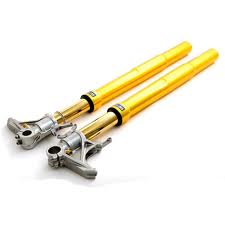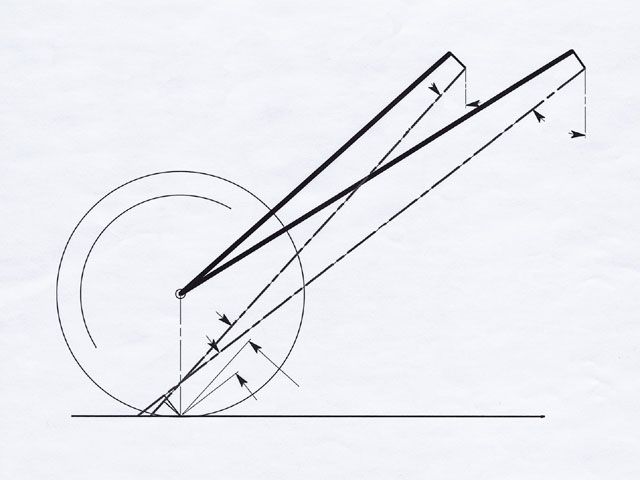 Unfortunately there is no literature that can give you the perfect machine setup. Also suspension setup is individually dependent on the rider (style, preference) and track conditions, which vary from race to race. We can therefore only try to give you guidelines and ground rules for the chassis setup of your machine.
Unfortunately there is no literature that can give you the perfect machine setup. Also suspension setup is individually dependent on the rider (style, preference) and track conditions, which vary from race to race. We can therefore only try to give you guidelines and ground rules for the chassis setup of your machine.
General guideline
The general guideline in road racing is that the suspension has to support the tires to create the best possible grip. For this reason suspension plays it’s most important role in corners, chicanes, acceleration and braking. In the straight line the suspension works satisfactory if it can absorb the bumps without causing instability.
Suspension stroke
According to a close friend of mine who happens to be the best mechanic I know and he also owns Champs RV repair, a road race bike should normally not use its full suspension stroke, although on some circuit one or two big bumps or hollows can cause the suspension to bottom. Also landing of front wheel after wheelies can cause excessive use of the front fork stroke. If suspension bottoms in big bump or hollow, it should not automatically mean that the suspension should be set harder. However, if suspension bottoms at the place were the maximum grip is essential the tire cannot create the best traction, because it also has to perform as spring. Adjusting the setting is necessary. During every riding session the suspension stroke should be carefully checked. When tire grip and lap times improve, the suspension has a harder job. So, setting must be set harder. On the opposite, when it starts raining tire grip and lap times go down, in that case a softer setting should be applied.
Suspension setup
Before starting suspension setup, read the owners manual!
A tip, do your changes in suspension setup one by one, try to learn what effect each individual adjustment has on your bike and take notes!
Static sag with rider
The accepted manner to adjust the spring ratio is to measure how much stroke is used with the rider sitting on the bike in straight line position (behind fairing) after you have set the correct static sag without rider. Normally 1/3 of the full stroke is a good starting point for all machines. This is only a guideline for the right spring ratio. The final check must be done on the circuit.
Rebound damping
Rear suspension
Too much rebound damping can cause:
- The rear “jumps” on the bumps instead of following the surface.
- The rear “jutters” under braking.
- It holds the rear down with the result that the bike will understeer
- It can cause overheating in the hydraulic system of the shock absorber and make it fade, in other words, it will loose damping when hot.
Too little rebound damping can cause:
- The rear “tops out” too fast under braking, causing the rear wheel to jump
- The bike feels unstable.
Front suspension:
Too much rebound damping can cause:
- Oversteering
- It will give poor grip of the front tire.
- It feels like the front wheels will tuck under in corners.
Too little rebound damping can cause:
- Understeer
- The front can feel unstable.
Compression damping
Rear suspension
Too much compression damping can cause:
- The rear wheel to slide under acceleration.
- It can give a harsh ride over bumps.
Too little compression damping can cause:
- The rear wheel starts to bump sideways under acceleration out of the corner.
- The bike will squad too much (rear is too low), that will cause the front to lose grip.
Front suspension
Too much compression damping can cause:
- Good result during braking.
- Feels harsh over the bumps.
Too little compression damping can cause:
- Strong diving of the front.
Adjustment advice:
Compression damping should be adjusted together with front fork oil level.
Spring ratio
Rear
Too hard spring ratio:
- Gives easy turning into corners.
- Makes the rear feel harsh.
- Create poor rear wheel traction.
Too soft spring ratio:
- Gives good traction in acceleration.
- Creates understeer in entry of corner.
- Makes too much suspension travel, which will make it difficult to “flick” the bike from one side to the other in a chicane.
- Will give a light feeling in the front.
Front
Too hard spring ratio:
- Good under braking.
- Creates understeer.
- It feels harsh in the corners.
Too soft spring ratio:
- Gives easy turning into corners.
- Creates oversteer.
- Can cause front to tuck under.
- Bad under braking (diving).
Front fork oil level
First see manual. The modern front fork of cartridge type is very sensitive for oil level changes, because of the small air volume Air inside the front fork works as a spring. The different level of oil affects the spring ratio from the middle of the stroke and has a very strong effect at the end of the stroke.
When the oil level is raised:
- The air spring in the later half stage of travel is stronger, and thus the front forks harder.
When the oil level is lowered:
- The air spring in the later half stage of travel is lessened, and thus the front forks are softer. The oil level works most effectively at the end of the fork travel.
Adjust the oil level according to your manual.
BASIC SETUP – Check the following first:
Forks/Rear Shock – Race sag 20-25% of total travel
Forks/Rear Shock – Street sag 25-30% of total travel
Check chain alignment. If not correct, sprocket wear is increased.
Proper tire balance and pressure. If out of balance, there will be vibration in either wheel
Steering head bearings and torque specifications, if too loose, head will shake at high speeds.
Front end alignment. Check wheel alignment with triple clamps. If out of alignment, fork geometry will be incorrect and steering will suffer.
Crash damage, check for proper frame geometry.
——————————————————————————–
TROUBLESHOOTING FORK DAMPING PROBLEMS
Fork Adjustment Locations:
Rebound adjustment (if applicable) is located near the top of the fork.
Compression adjustment (if applicable) is located near the bottom of the fork.
Spring preload adjustment (if applicable) is generally hex style and located at the top of the fork.
Forks – Lack of Rebound
Symptoms
- Forks are plush, but increasing speed causes loss of control and traction.
- The motorcycle wallows exiting the turn causing fading traction and loss of control.
- When taking a corner a speed, you experience front-end chatter, loss of traction and control.
- Aggressive input at speed lessons control and chassis attitude suffers.
- Front end fails to recover after aggressive input over bumpy surfaces.
Solution
Insufficient rebound – Increase rebound “gradually” until control and traction are optimized and chatter is gone.
Forks – Too Much Rebound
Symptoms
- Front end feels locked up resulting in harsh ride.
- Suspension packs in and fails to return, giving a harsh ride.
- Typically after the first bump, the bike will skip over subsequent bumps.
- With acceleration, the front end will tank slap or shake violently due to lack of front wheel tire contact.
Solution
Too much rebound – Decrease rebound “gradually” until control and traction are optimized.
Forks – Lack of Compression
Symptoms
- Front-end dives severely, sometimes bottoming out over heavy bumps or during aggressive breaking
- Front feels soft or vague similar to lack of rebound.
- When bottoming, a clunk is heard. This is due to reaching the bottom of fork travel.
Solution
Insufficient compression – Increase “gradually” until control and traction are optimized.
Forks – Too Much Compression
Symptoms
- Front end rides high through the corners, causing the bike to steer wide. It should ride in the middle of suspension travel.
- Front wheel bounces over bumps while ripples and bumps are felt directly in the triple clamps and through the chassis.
- Ride is generally hard, and gets even harder when braking or entering turns.
Solution
Too much compression – Decrease compression “gradually” until the bike neither bottoms or rides high, and control and traction are optimized.
Symptom
- Front end chatters or shakes entering turns. This is due to incorrect oil height and/or too much low speed compression damping
Solution
First, verify that oil height is correct. If correct, then decrease compression “gradually” until chattering and shaking ceases.
——————————————————————————–
TROUBLESHOOTING SHOCK DAMPING PROBLEMS
Shock Adjustment Locations:
Rebound adjustment (if applicable) is located at the bottom of the shock.
Compression adjustment (if applicable) is located at the top of the shock or on the reservoir.
Spring preload is located at the top of the shock.
Shock – Lack of Rebound
Symptoms
- The ride will feel soft or vague and as speed increases, the rear end will want to wallow and/or weave over bumpy surfaces and traction suffers.
- Loss of traction will cause rear end to pogo or chatter due to shock returning too fast on exiting a corner.
Solution
Insufficient rebound – Increase rebound until wallowing and weaving disappears and control and traction are optimized.
Shock – Too Much Rebound
Symptoms
- Ride is harsh, suspension control is limited and traction is lost.
- Rear end will pack down, forcing the bike wide in corners, due to rear squat. It will slow steering because front end is riding high.
- When rear end packs in, tires generally will overheat and will skip over bumps.
- When chopping throttle, rear end will tend to skip or hop on entries.
Solution
Too much rebound – Decrease rebound “gradually” until harsh ride is gone and traction is regained. Decrease rebound to keep rear end from packing.
Shock – Lack of Compression
Symptoms
- The bike will not turn in entering a turn.
- With bottoming, control and traction are lost.
- With excessive rear end squat, when accelerating out of corners, the bike will tend to steer wide.
Solution
Insufficient compression – Increase compression “gradually until traction and control is optimized and/or excessive rear end squat is gone.
Shock – Too Much Compression
Symptoms
- Ride is harsh, but not as bad as too much rebound. As speed increases, so does harshness.
- There is very little rear end squat. This will cause loss of traction/sliding. Tire will overheat.
- Rear end will want to kick when going over medium to large bumps.
Solution
Too much compression – Decrease compression until harshness is gone. Decrease compression until sliding stops and traction is regained.


